Order Artiodactyla Length Vaquita: 1.5 m | Phylum Chordata Scientific name Phocoenidae Lifespan 8 – 10 years Rank Family | |
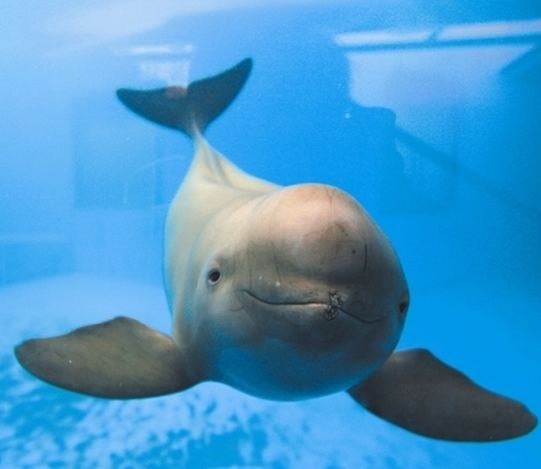 | ||
Mass Harbour porpoise: 53 kg, Vaquita: 43 kg Lower classifications Harbour porpoise, Vaquita, Phocoena, Finless porpoise, Dall's porpoise | ||
10 differences between dolphins and porpoises
Porpoises are a group of fully aquatic marine mammals that are sometimes referred to as mereswine, all of which are classified under the family Phocoenidae, parvorder Odontoceti (toothed whales). There are six extant species of porpoise. They are small toothed whales that are very closely related to oceanic dolphins. The most obvious visible difference between the two groups is that porpoises have shorter beaks and flattened, spade-shaped teeth distinct from the conical teeth of dolphins. Porpoises, and other cetaceans, belong to the clade Cetartiodactyla with even-toed ungulates, and their closest living relatives are the hippopotamuses, having diverged from them about 40 million years ago.
Contents
- 10 differences between dolphins and porpoises
- Taxonomy and evolution
- Anatomy
- Locomotion
- Senses
- Sleep
- Life cycle
- Diet
- Research history
- In captivity
- Drive hunting
- Fishing
- Environmental hazards
- Conservation
- References
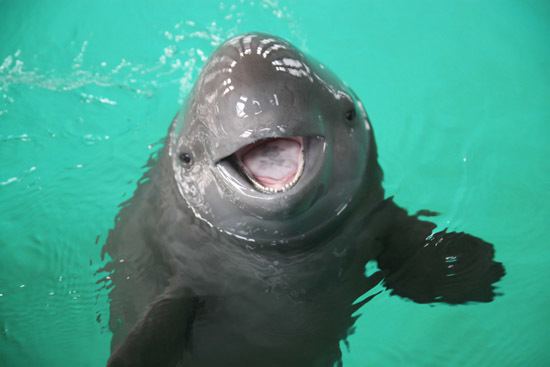
Porpoises range in size from the 1.4 metres (4.6 ft) and 54 kilograms (119 lb) vaquita, the smallest cetacean to be discovered, to the 2.3 metres (7.5 ft) and 220 kilograms (490 lb) Dall's porpoise. Several species exhibit sexual dimorphism in that the females are larger than males. They have streamlined bodies and two limbs that are modified into flippers. Dall's porpoise is one of the fastest cetaceans discovered, with the ability to travel at 41 knots (76 km/h). Porpoises have the ability to produce biosonar and it is their primary sensory system. Some species are well adapted for diving to great depths. They have a layer of fat, or blubber, under the skin to keep them warm in cold water.
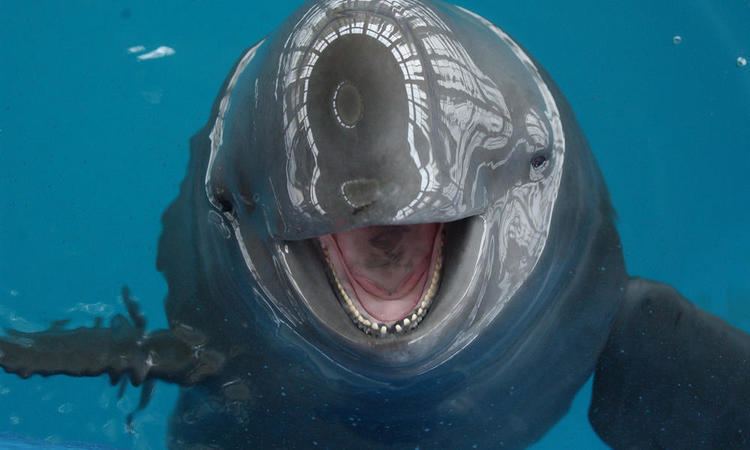
Porpoises are not very widespread, with many specialising near the polar regions, usually near the coast. Porpoises feed largely on fish and squid, much like the rest of the odontocetes. Males typically mate with multiple females every year, but females only mate every two to three years. Calves are typically born in the spring and summer months and females bear all the responsibility for raising them. Some porpoises produce a variety of clicks and whistles, which are thought to be primarily for social purposes. A few species, like the harbour porpoise, are highly sociable, but pods generally do not exceed ten individuals for most species.
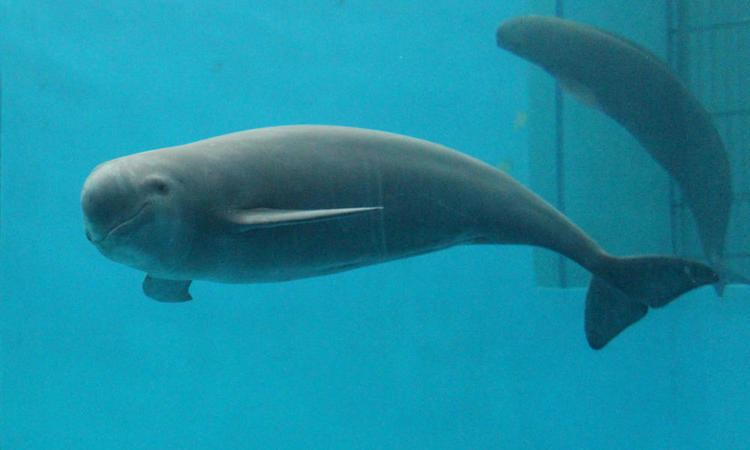
Porpoises were, and still are, hunted by some countries by means of drive hunting. Some species are attributed with high levels of intelligence. At the 2012 meeting of the American Association for the Advancement of Science, support was reiterated for a cetacean bill of rights, listing cetaceans as non-human persons. The vaquita nearly became extinct in the twentieth century, with a predicted population of fewer than 100 individuals, and, since the extinction of the baiji, is considered the most endangered cetacean. Besides drive hunting, they also face threats from bycatch, competition (from humans), and marine pollution. Porpoises are sometimes kept in captivity and trained to perform tricks, but breeding success has been poor.
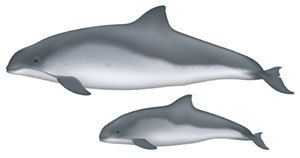
Taxonomy and evolution
Porpoises, along with whales and dolphins, are descendants of land-living ungulates (hoofed animals) that first entered the oceans around 50 million years ago (Mya). During the Miocene (23 to 5 Mya), mammals were fairly modern, meaning they seldom changed physiologically from the time. The cetaceans diversified, and fossil evidence suggests porpoises and dolphins diverged from their last common ancestor around 15 Mya. The oldest fossils are known from the shallow seas around the North Pacific, with animals spreading to the European coasts and Southern Hemisphere only much later, during the Pliocene.
Recently discovered hybrids between male harbour porpoises and female Dall's porpoises indicate the two species may actually be members of the same genus.
Anatomy
Porpoises have a bulbous head, no external ear flaps, a non-flexible neck, a torpedo shaped body, limbs modified into flippers, and a tail fin. Their skull has small eye orbits, small, blunt snouts, and eyes placed on the sides of the head. Porpoises range in size from the 1.4 metres (4.6 ft) and 54 kilograms (119 lb) Vaquita to the 2.3 metres (7.5 ft) and 220 kilograms (490 lb) Dall's porpoise. Overall, they tend to be dwarfed by other cetaceans. Almost all species have female-biased sexual dimorphism, with the females being larger than the males, although those physical differences are generally small; one exception is Dall's porpoise.
Odontocetes possess teeth with cementum cells overlying dentine cells. Unlike human teeth, which are composed mostly of enamel on the portion of the tooth outside of the gum, whale teeth have cementum outside the gum. Porpoises, like other odontocetes, possess only one blowhole. Breathing involves expelling stale air from the blowhole, forming an upward, steamy spout, followed by inhaling fresh air into the lungs. All porpoises have a thick layer of blubber. This blubber can help with insulation from the harsh underwater climate, protection to some extent as predators would have a hard time getting through a thick layer of fat, and energy for leaner times. Calves are born with only a thin layer of blubber, but some species compensate for this with a covering of fine, downy hair known as lanugo.
Porpoises have a two-chambered stomach that is similar in structure to those of terrestrial carnivores. They have fundic and pyloric chambers.
Locomotion
Porpoises have two flippers on the front, and a tail fin. Although porpoises do not possess fully developed hind limbs, they possess discrete rudimentary appendages, which may contain feet and digits. Their flippers, for example, contain four digits. Porpoises are fast swimmers in comparison to seals, which typically cruise at 5–15 kn, or 9–28 kilometres per hour (5.6–17.4 mph); Dall's porpoise, in comparison, can travel at speeds up to 74 kilometres per hour (46 mph). The fusing of the neck vertebrae, while increasing stability when swimming at high speeds, decreases flexibility, making it impossible for them to turn their head. When swimming, they move their tail fin and lower body up and down, propelling themselves through vertical movement, while their flippers are mainly used for steering. Flipper movement is continuous. Some species log out of the water, which may allow then to travel faster, and sometimes they porpoise out of the water, meaning jump out of the water. Their skeletal anatomy allows them to be fast swimmers. They have a very well defined and triangular dorsal fin, allowing them to steer better in the water. Unlike their dolphin counterparts, they are adapted for coastal shores, bays, and estuaries.
Senses
The porpoise ear has specific adaptations to the marine environment. In humans, the middle ear works as an impedance equaliser between the outside air's low impedance and the cochlear fluid's high impedance. In whales, and other marine mammals, there is no great difference between the outer and inner environments. Instead of sound passing through the outer ear to the middle ear, porpoises receive sound through the throat, from which it passes through a low-impedance fat-filled cavity to the inner ear. The porpoise ear is acoustically isolated from the skull by air-filled sinus pockets, which allow for greater directional hearing underwater. Odontocetes send out high frequency clicks from an organ known as a melon. This melon consists of fat, and the skull of any such creature containing a melon will have a large depression. The large bulge on top of the porpoises head is caused by the melon.
The porpoise eye is relatively small for its size, yet they do retain a good degree of eyesight. As well as this, the eyes of a porpoise are placed on the sides of its head, so their vision consists of two fields, rather than a binocular view like humans have. When porpoises surface, their lens and cornea correct the nearsightedness that results from the refraction of light; their eyes contain both rod and cone cells, meaning they can see in both dim and bright light. Porpoises do, however, lack short wavelength sensitive visual pigments in their cone cells indicating a more limited capacity for colour vision than most mammals. Most porpoises have slightly flattened eyeballs, enlarged pupils (which shrink as they surface to prevent damage), slightly flattened corneas and a tapetum lucidum; these adaptations allow for large amounts of light to pass through the eye and, therefore, they are able to form a very clear image of the surrounding area.
The olfactory lobes are absent in porpoises, suggesting that they have no sense of smell.
Porpoises are not thought to have a good sense of taste, as their taste buds are atrophied or missing altogether. However, some have preferences between different kinds of fish, indicating some sort of attachment to taste.
Sleep
Unlike most animals, porpoises are conscious breathers. All mammals sleep, but porpoises cannot afford to become unconscious for long because they may drown. While knowledge of sleep in wild cetaceans is limited, porpoises in captivity have been recorded to sleep with one side of their brain at a time, so that they may swim, breathe consciously, and avoid both predators and social contact during their period of rest.
Life cycle
Porpoises are fully aquatic creatures. Females deliver a single calf after a gestation period lasting about a year. Calving takes place entirely under water, with the foetus positioned for tail-first delivery to help prevent drowning. Females have mammary glands, but the shape of a newborn calf's mouth does not allow it to obtain a seal around the nipple— instead of the calf sucking milk, the mother squirts milk into the calf's mouth. This milk contains high amounts of fat, which aids in the development of blubber; it contains so much fat that it has the consistency of toothpaste. The calves are weaned at about 11 months of age. Males play no part in rearing calves. The calf is dependent for one to two years, and maturity occurs after seven to ten years, all varying between species. This mode of reproduction produces few offspring, but increases the probability of each one surviving.
Diet
Porpoises eat a wide variety of creatures. The stomach contents of harbour porpoises suggests that they mainly feed on benthic fish, and sometimes pelagic fish. They may also eat benthic invertebrates. In rare cases, algae, such as Ulva lactuca, is consumed. Atlantic porpoises are thought to follow the seasonal migration of bait fish, like herring, and their diet varies between seasons. The stomach contents of Dall's porpoises reveal that they mainly feed on cephalopods and bait fish, like capelin and sardines. Their stomachs also contained some deep-sea benthic organisms.
The finless porpoise is known to also follow seasonal migrations. It is known that populations in the mouth of the Indus River migrate to the sea from April through October to feed on the annual spawning of prawns. In Japan, sightings of small pods of them herding sand lance onto shore are common year-round.
Little is known about the diets of other species of porpoises. A dissection of three Burmeister's porpoises shows that they consume shrimp and euphausiids. A dissection of a beached Vaquita showed remains of squid and grunts. Nothing is known about the diet of the spectacled porpoise.
Research history
In Aristotle's time, the 4th century BCE, porpoises were regarded as fish due to their superficial similarity. Aristotle, however, could already see many physiological and anatomical similarities with the terrestrial vertebrates, such as blood (circulation), lungs, uterus and fin anatomy. His detailed descriptions were assimilated by the Romans, but mixed with a more accurate knowledge of the dolphins, as mentioned by Pliny the Elder in his “Natural history”. In the art of this and subsequent periods, porpoises are portrayed with a long snout (typical of dolphins) and a high-arched head. The harbour porpoise was one of the most accessible species for early cetologists, because it could be seen very close to land, inhabiting shallow coastal areas of Europe. Much of the findings that apply to all cetaceans were first discovered in porpoises. One of the first anatomical descriptions of the airways of the whales on the basis of a harbor porpoise dates from 1671 by John Ray. It nevertheless referred to the porpoise as a fish.
In captivity
Porpoises, as opposed to their dolphin counterparts, don't thrive in captivity, and it is very difficult to maintain a porpoise. Currently, there are five porpoises in captivity, two in Vancouver, and three in Hiroshima. Among their collection, the reopened Miyajima Aquarium in Hiroshima houses many sea creatures, among them are three finless porpoises. In the Vancouver Aquarium, there is a harbour porpoise on display, Daisy, who beached herself into Horseshoe Bay in 2008.
Harbour porpoises have historically been kept in captivity, under the assumption that they would fare better than their dolphin counterparts due to their shallow-water habitats. Of the 150 harbour porpoises kept worldwide, nearly 100 were kept in Denmark. Nearly half of these died of diseases caught before they were captured, or damage sustained during capture and transit. Almost all died within 14 months. Breeding success has always been poor with porpoises, and there are only six recorded births (of a harbour porpoise and five finless porpoises). Lack of births in captivity is mainly due the fact that there were few breeding attempts, many were actually kept in isolation and those who were not were often not mature.
Finless porpoises have commonly been kept in Japan, as well as China and Indonesia. Ninety four in total have been in captivity in Japan, eleven in China, and at least two in Indonesia. Japan has had three establishments designated for breeding them, and there have been five recorded births. Three calves died moments after their birth, but two survived for several years. This breeding success proved that porpoises can be successfully bred in captivity, and this could open up new conservation options.
Dall's porpoises have been kept in captivity, but not in great numbers. Nine were captured in the U.S. and nine more in Japan, a total of eighteen, but none were successfully kept in captivity. There were considerable difficulties dealing with these animals, most of them rammed their heads at the walls and the bottom. They sometimes refused to feed. The skin was sloughed at an early stage due to speed limitation in their confining tanks. A male showed irritable behaviour. None of the Dall's porpoises survived for long.
Drive hunting
Porpoises and other smaller cetaceans, mainly dolphins, are hunted in an activity known as drive hunting. This is accomplished by driving a pod together with boats and usually into a bay or onto a beach. Their escape is prevented by closing off the route to the ocean with other boats or nets. Porpoises are hunted this way in several places around the world, including the Solomon Islands, the Faroe Islands, Peru, and Japan, the most well-known practitioner of this method. By numbers, porpoises are mostly hunted for their meat, though some end up in dolphinariums. Despite the controversial nature of the hunt resulting in international criticism, and the possible health risk that the high methylmercury levels impose, thousands of porpoises are caught in drive hunts each year.
Fishing
Porpoises are highly affected by bycatch. Many porpoises, mainly the vaquita, are subject to great mortality due to gillnetting. Although it is the world's most endangered marine cetacean, the vaquita continues to be caught in small-mesh gillnet fisheries throughout much of its range. Incidental mortality caused by the fleet of El Golfo de Santa Clara was estimated to be at around 39 vaquitas per year, which is over 17% of the population size. Harbour porpoises also suffer drowning by gillnetting, but on a less threatening scale due to their high population; their mortality rate per year increases a mere 5% due to this.
The fishing market, historically has always had a porpoise bycatch. In 1981, it was legal to kill 22,500 porpoises per year to catch yellowfin tuna. This type of tuna has been known to follow porpoises, and when fishermen find these tuna, more often than not, a porpoise is also entangled in a net. Sometimes, a pod of porpoises are herded along with schools of tuna, and when fishermen cast a seine, the porpoises are trapped in the net, and drown because they can't surface. Today, the Marine Mammal Protection Act of 1972 has enforced the use of safer fishing equipment to reduce bycatch.
Environmental hazards
Porpoises are very sensitive to anthropogenic disturbances, and are keystone species, which can indicate the overall health of the marine environment. Populations of harbor porpoises in the North and Baltic Seas are under increasing pressure from anthropogenic causes such as offshore construction, ship traffic, fishing, and military exercises. Increasing pollution is a serious problem for marine mammals. Heavy metals and plastic waste are not biodegradable, and sometimes cetaceans consume these hazardous materials, mistaking them for food items. As a result, the animals are more susceptible to diseases and have fewer offspring. Harbour porpoises from the English Channel were found to have accumulated heavy metals.
The military and geologists employ strong sonar and produce an increases in noise in the oceans. Marine mammals that make use of biosonar for orientation and communication are not only hindered by the extra noise, but may race to the surface in panic. This may lead to a bubbling out of blood gases, and the animal then dies because the blood vessels become blocked, so-called decompression sickness. This effect, of course, only occurs in porpoises that dive to great depths, such as Dall's porpoise.
Additionally, civilian vessels produce sonar waves in order to measure the depth of the body of water in which they are. Similar to the navy, some boats produce waves that attract porpoises, while others may repel them. The problem with the waves that attract is that the animal may be injured or even killed by being hit by the vessel or its propeller.
Conservation
The Harbour porpoise, spectacled porpoise, Burmeister's porpoise, and Dall's porpoise are all listed on Appendix II of the Convention on the Conservation of Migratory Species of Wild Animals (CMS). In addition, the Harbour porpoise is covered by the Agreement on the Conservation of Small Cetaceans of the Baltic, North East Atlantic, Irish and North Seas (ASCOBANS), the Agreement on the Conservation of Cetaceans in the Black Sea, Mediterranean Sea and Contiguous Atlantic Area (ACCOBAMS) and the Memorandum of Understanding Concerning the Conservation of the Manatee and Small Cetaceans of Western Africa and Macaronesia. Their conservation statuses are either at least concern or data deficient.
As of 2014, only five hundred and five Yangtze finless porpoises remained in the main section of the Yangtze, with an alarming population density in Ezhou and Zhenjiang. While many threatened species decline rate slows after their classification, population decline rates of the porpoise are actually accelerating. While population decline tracked from 1994 to 2008 has been pegged at a rate of 6.06% annually, from 2006 to 2012, the porpoise population decreased by more than half. Finless porpoise population decrease of 69.8% in just a 22-year span from 1976 to 2000. 5.3%. A majority of factors of this population decline are being driven by the massive growth in Chinese industry since 1990 which caused increased shipping and pollution and ultimately environmental degradation. Some of these can be seen in damming of the river as well as illegal fishing activity. To protect the species, China's Ministry of Agriculture classified the species as being National First Grade Key Protected Wild Animal, the strictest classification by law, meaning it is illegal to bring harm to a porpoise. Protective measures in the Tian-e-Zhou Oxbow Nature Reserve has increased its population of porpoises from five to forty in twenty five years. The Chinese Academy of Science's Wuhan Institute of Hydrobiology has been working with the World Wildlife Fund to ensure the future for this subspecies, and have placed five porpoises in another well-protected area, the He-wang-miao oxbow. Five protected natural reserves have been established in areas of the highest population density and mortality rates with measures being taken to ban patrolling and harmful fishing gear in those areas. There have also been efforts to study porpoise biology to help specialize conservation through captivation breeding. The Baiji Dolphinarium, was established in 1992 at the Institute of Hydrobiology of the Chinese Academy of Sciences in Wuhan which allowing the study of behavioral and biological factors affecting the finless porpoise, specifically breeding biology like seasonal changes in reproductive hormones and breeding behavior.
Because vaquitas are indigenous to the Gulf of California, Mexico is leading conservation efforts with the creation of the International Committee for the Recovery of the Vaquita (CIRVA), which has tried to prevent the accidental deaths of vaquitas by outlawing the use of fishing nets within the vaquita's habitat. CIRVA has worked together with the CITES, the Endangered Species Act, and the Marine Mammal Protection Act (MMPA) to nurse the vaquita population back to a point at which they can sustain themselves. CIRVA concluded in 2000 that between 39 and 84 individuals are killed each year by such gillnets. In order to try to prevent extinction, the Mexican government has created a nature reserve covering the upper part of the Gulf of California and the Colorado River delta. They have also placed a temporary ban on fishing, with compensation to those affected, that may pose a threat to the vaquita.
